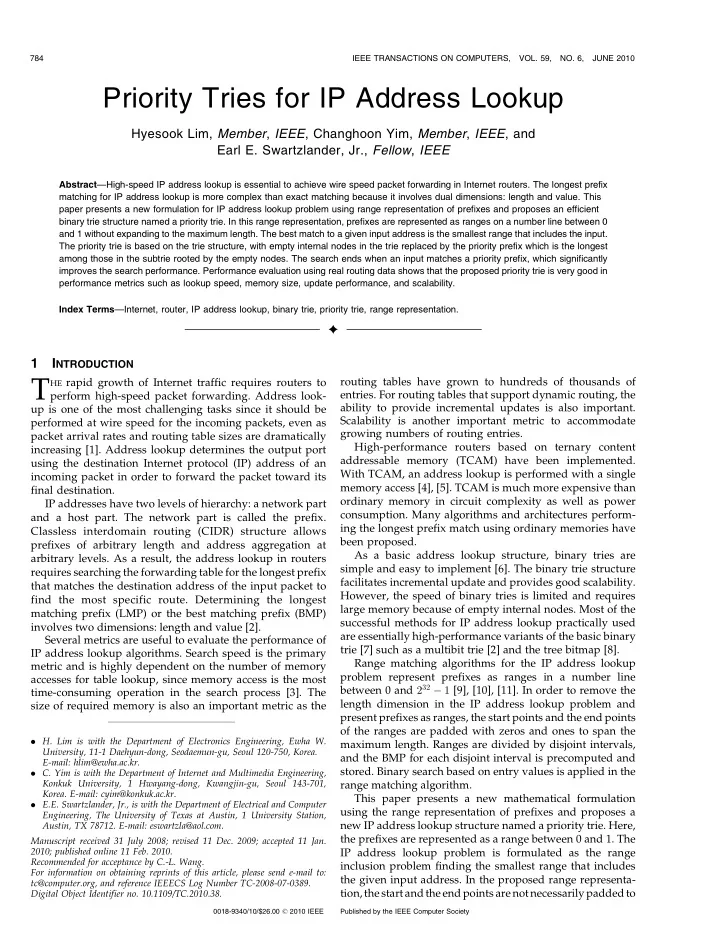

784 IEEE TRANSACTIONS ON COMPUTERS, VOL. 59, NO. 6, JUNE 2010 Priority Tries for IP Address Lookup Hyesook Lim, Member , IEEE , Changhoon Yim, Member , IEEE , and Earl E. Swartzlander, Jr., Fellow , IEEE Abstract —High-speed IP address lookup is essential to achieve wire speed packet forwarding in Internet routers. The longest prefix matching for IP address lookup is more complex than exact matching because it involves dual dimensions: length and value. This paper presents a new formulation for IP address lookup problem using range representation of prefixes and proposes an efficient binary trie structure named a priority trie. In this range representation, prefixes are represented as ranges on a number line between 0 and 1 without expanding to the maximum length. The best match to a given input address is the smallest range that includes the input. The priority trie is based on the trie structure, with empty internal nodes in the trie replaced by the priority prefix which is the longest among those in the subtrie rooted by the empty nodes. The search ends when an input matches a priority prefix, which significantly improves the search performance. Performance evaluation using real routing data shows that the proposed priority trie is very good in performance metrics such as lookup speed, memory size, update performance, and scalability. Index Terms —Internet, router, IP address lookup, binary trie, priority trie, range representation. Ç 1 I NTRODUCTION T routing tables have grown to hundreds of thousands of HE rapid growth of Internet traffic requires routers to entries. For routing tables that support dynamic routing, the perform high-speed packet forwarding. Address look- ability to provide incremental updates is also important. up is one of the most challenging tasks since it should be Scalability is another important metric to accommodate performed at wire speed for the incoming packets, even as growing numbers of routing entries. packet arrival rates and routing table sizes are dramatically High-performance routers based on ternary content increasing [1]. Address lookup determines the output port addressable memory (TCAM) have been implemented. using the destination Internet protocol (IP) address of an With TCAM, an address lookup is performed with a single incoming packet in order to forward the packet toward its memory access [4], [5]. TCAM is much more expensive than final destination. ordinary memory in circuit complexity as well as power IP addresses have two levels of hierarchy: a network part consumption. Many algorithms and architectures perform- and a host part. The network part is called the prefix. ing the longest prefix match using ordinary memories have Classless interdomain routing (CIDR) structure allows been proposed. prefixes of arbitrary length and address aggregation at As a basic address lookup structure, binary tries are arbitrary levels. As a result, the address lookup in routers simple and easy to implement [6]. The binary trie structure requires searching the forwarding table for the longest prefix facilitates incremental update and provides good scalability. that matches the destination address of the input packet to However, the speed of binary tries is limited and requires find the most specific route. Determining the longest large memory because of empty internal nodes. Most of the matching prefix (LMP) or the best matching prefix (BMP) successful methods for IP address lookup practically used involves two dimensions: length and value [2]. are essentially high-performance variants of the basic binary Several metrics are useful to evaluate the performance of trie [7] such as a multibit trie [2] and the tree bitmap [8]. IP address lookup algorithms. Search speed is the primary Range matching algorithms for the IP address lookup metric and is highly dependent on the number of memory problem represent prefixes as ranges in a number line accesses for table lookup, since memory access is the most between 0 and 2 32 � 1 [9], [10], [11]. In order to remove the time-consuming operation in the search process [3]. The length dimension in the IP address lookup problem and size of required memory is also an important metric as the present prefixes as ranges, the start points and the end points of the ranges are padded with zeros and ones to span the . H. Lim is with the Department of Electronics Engineering, Ewha W. maximum length. Ranges are divided by disjoint intervals, University, 11-1 Daehyun-dong, Seodaemun-gu, Seoul 120-750, Korea. and the BMP for each disjoint interval is precomputed and E-mail: hlim@ewha.ac.kr. stored. Binary search based on entry values is applied in the . C. Yim is with the Department of Internet and Multimedia Engineering, Konkuk University, 1 Hwayang-dong, Kwangjin-gu, Seoul 143-701, range matching algorithm. Korea. E-mail: cyim@konkuk.ac.kr. This paper presents a new mathematical formulation . E.E. Swartzlander, Jr., is with the Department of Electrical and Computer using the range representation of prefixes and proposes a Engineering, The University of Texas at Austin, 1 University Station, new IP address lookup structure named a priority trie. Here, Austin, TX 78712. E-mail: eswartzla@aol.com. the prefixes are represented as a range between 0 and 1. The Manuscript received 31 July 2008; revised 11 Dec. 2009; accepted 11 Jan. 2010; published online 11 Feb. 2010. IP address lookup problem is formulated as the range Recommended for acceptance by C.-L. Wang. inclusion problem finding the smallest range that includes For information on obtaining reprints of this article, please send e-mail to: the given input address. In the proposed range representa- tc@computer.org, and reference IEEECS Log Number TC-2008-07-0389. tion, the start andthe end points are not necessarily padded to Digital Object Identifier no. 10.1109/TC.2010.38. 0018-9340/10/$26.00 � 2010 IEEE Published by the IEEE Computer Society
Recommend
More recommend